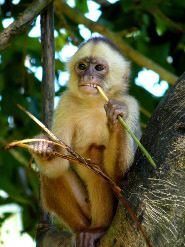 The White-fronted Capuchin (Cebus albifrons) is a small, omnivorous monkey found throughout the northern half of South America. The primate's range currently stretches across seven countries: Bolivia, Brazil, Colombia, Venezuela, Ecuador, Peru, and Trinidad. The animal was discovered by Alexander von Humboldt in 1812, although there was some confusion about the description of the animal because of the various colors found across the 5 different subspecies. The primate is usually a creamy white color in front (hence the name White-fronted Capuchin), although the area that is "white" in the front can range from a creamy white color to a cinnamon brown color depending on the subspecies. Males are larger than females, with males averaging 3.4 kg (7.5 lb) while females average 2.9 kg (6.4 lb).
The White-fronted Capuchin (Cebus albifrons) is a small, omnivorous monkey found throughout the northern half of South America. The primate's range currently stretches across seven countries: Bolivia, Brazil, Colombia, Venezuela, Ecuador, Peru, and Trinidad. The animal was discovered by Alexander von Humboldt in 1812, although there was some confusion about the description of the animal because of the various colors found across the 5 different subspecies. The primate is usually a creamy white color in front (hence the name White-fronted Capuchin), although the area that is "white" in the front can range from a creamy white color to a cinnamon brown color depending on the subspecies. Males are larger than females, with males averaging 3.4 kg (7.5 lb) while females average 2.9 kg (6.4 lb).While the primate is primarily arboreal, it forages for food at all different levels of the forest. The animal often goes to the forest floor to obtain its diet that consists primarily of fruits, insects, frogs, lizards, and bird eggs. One of the notable traits of the White-fronted Capuchin is that it is a primate that is capable of manipulating objects; while it is common for larger, more advanced primates like chimpanzee to manipulate objects, the White-fronted Capuchin is one of the few small primates that have exhibited this trait.
Only one baby is born at a time, and all members of a troop participate in playing with and helping raise the young.
The major predators of the White-fronted Capuchin are the boa constrictor and a bird of prey that shares its habitat called the Double-toothed Kite. When confronted with a predator, the primate will either exhibit aggressive behavior or descend to the forest floor and run. Aggressive behavior to predators or intruders typically takes the form of screams and the breaking of branches. Because of its wide range and ability to adapt, the White-fronted Capuchin is not yet considered endangered. There is, however, a concern that as their habitats continue to shrink in South America, the White-fronted Capuchin population may decrease.
Picture of the white-fronted capuchin by Whaldener Endo, licensed under Creative Commons Attribution 2.5 Generic
The White-fronted capuchin is listed as Least Concern. Does not qualify for a more at risk category. Widespread and abundant taxa are included in this category, on the IUCN Red List of Threatened Species
Some facts about the
White-fronted capuchin
Adult weight : 2.468 kg (5.4296 lbs)
Maximum longevity : 40 years
Female maturity :1310 days
Male maturity : 1310 days
Gestation : 158 days
Weaning : 274 days
Litter size : 1
Litters per year : 1
Interval between litters : 547 days
Weight at birth : 0.233 kg (0.5126 lbs)

Custom Search